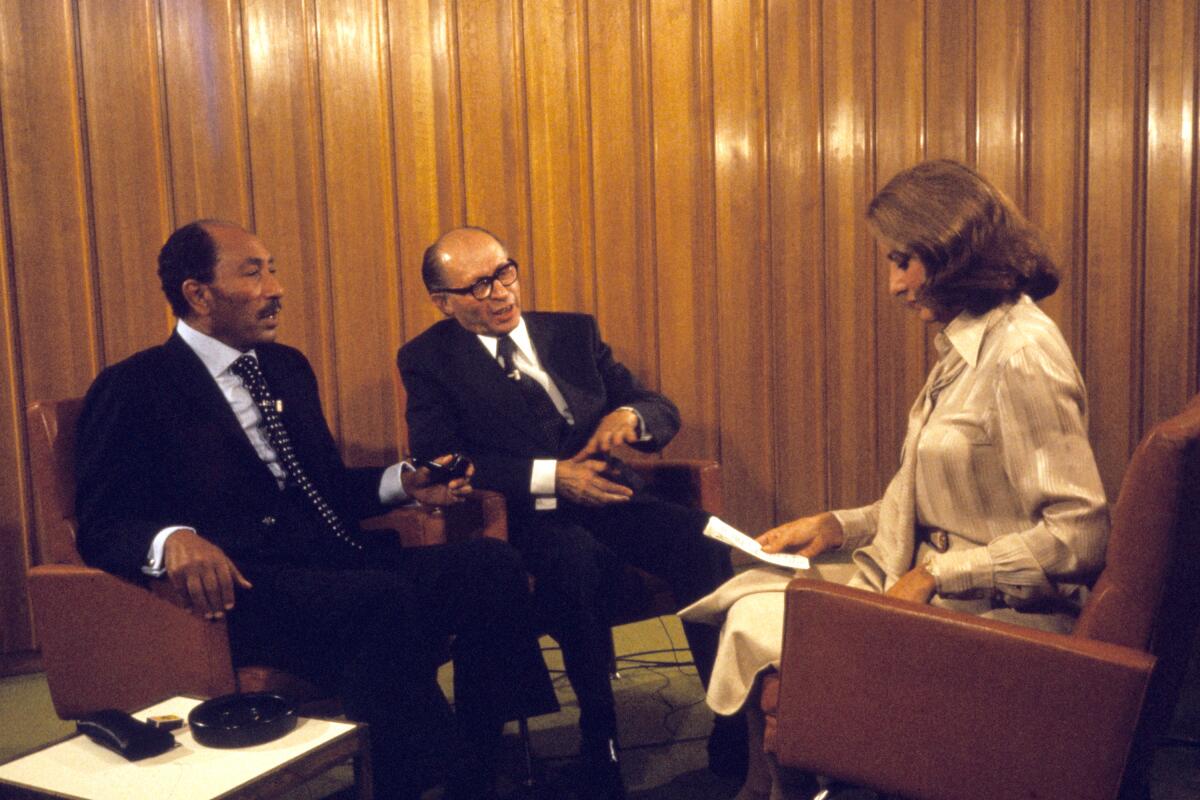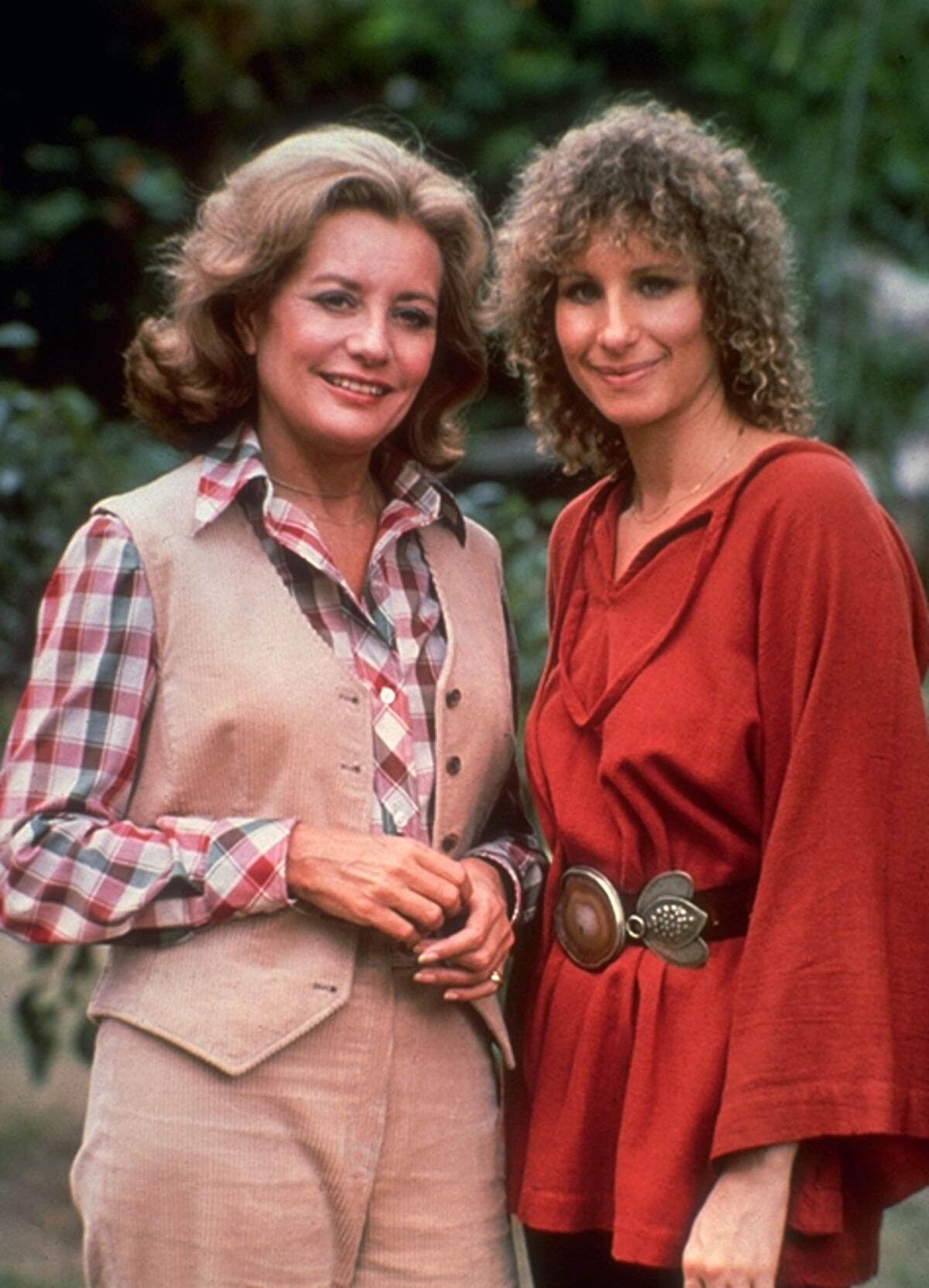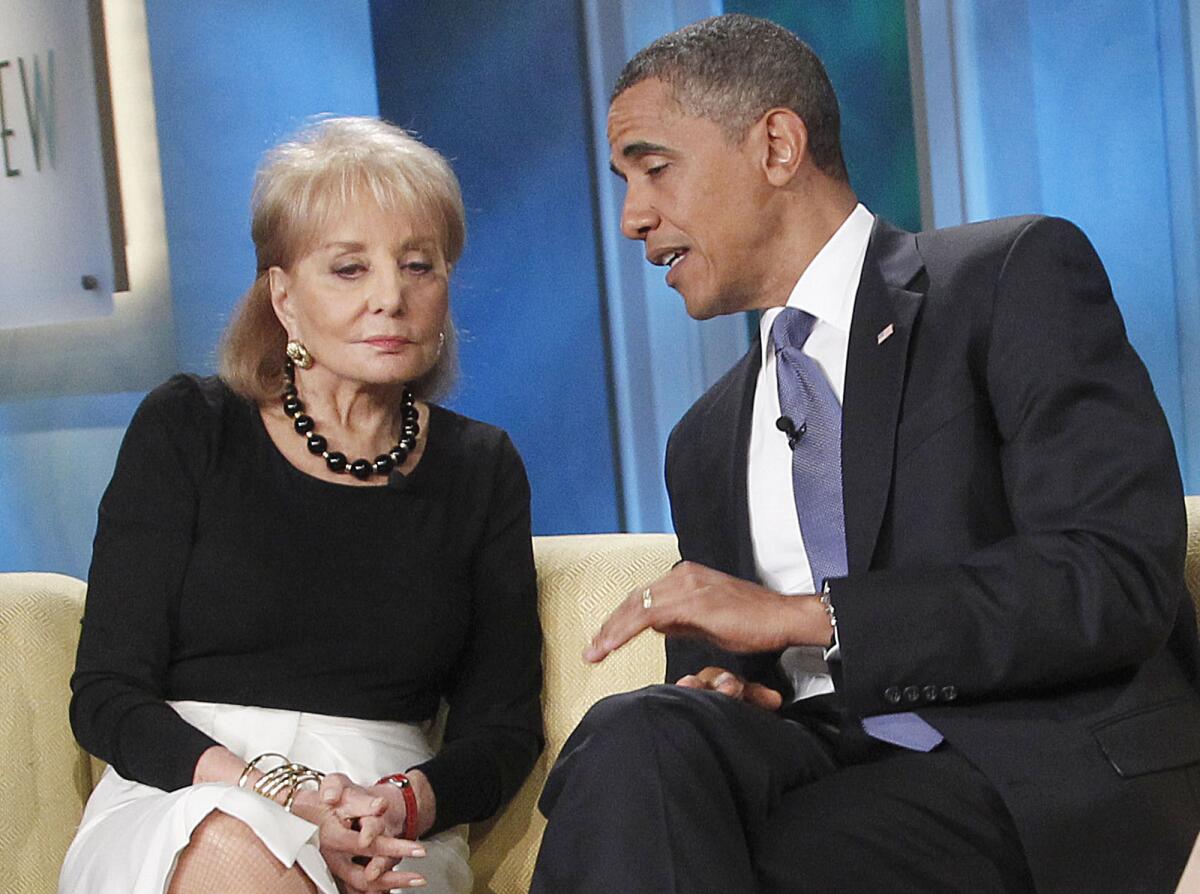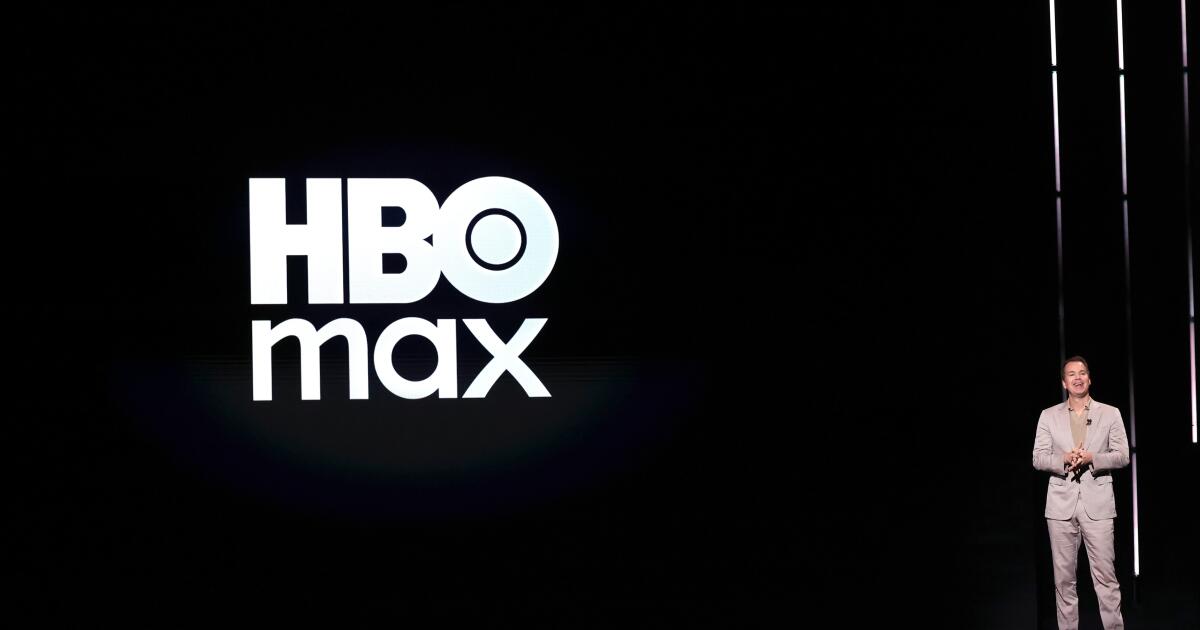‘Barbara Walters: Tell Me Everything’ examines anchor’s influence

There is no single figure in television history whose longevity and influence match Barbara Walters’.
She became a star on NBC’s “Today” in the early 1960s, raising the stature of the morning franchise. She opened doors for women as a network anchor and turned newsmaker interviews into major television events — 74 million tuned into her 1999 sit-down with Monica Lewinsky. She created one of daytime TV’s longest-running hits with “The View,” which evolved into a major forum for the country’s political discourse.
“The audience size that Barbara was able to capture and harness is unmatched in today’s world,” said Jackie Jesko, director of the new documentary “Barbara Walters: Tell Me Everything,” debuting Monday on Hulu after its premiere at the Tribeca Film Festival earlier this month. “Everything she did sort of made a difference.”
Jesko’s feature — produced by Brian Grazer and Ron Howard’s Imagine Documentaries and ABC News Studios — is the first in-depth look into Walters’ storied career. The film also serves as a sweeping historical review of the decades-long dominance of network news that made figures such as Walters a gatekeeper of the culture, as Jesko describes her.
Before the advent of social media and podcasts that allowed celebrities to control their messages, going through the X-ray machine of a Barbara Walters interview delivered exposure on a massive scale. David Sloan, a longtime ABC News producer who worked with Walters, recalls how the screen images of her specials flickered through the windows of Manhattan apartment towers.
“Tell Me Everything” came together not long after Walters died at the age of 93 in 2022. Sara Bernstein, president of Imagine Documentaries, approached Betsy West, executive producer and co-director of the Julia Child documentary “Julia,” about taking on a Walters project. Sloan, who oversaw an Emmy-winning tribute after Walters’ death, also wanted a deeper exploration into the impact of her career. West, also a former Walters colleague, and Sloan became executive producers on the film. “Tell Me Everything” taps deeply into the ABC News archives, which contain thousands of hours of interviews Walters conducted over her 40 years at the network.

Former President Richard M. Nixon during an interview with Barbara Walters in 1980 for ABC.
(Ray Stubblebine / AP)
Imagine not only gained access to program content but also outtakes that give parts of the film a cinema vérité-like look at Walters on the job. The newly unearthed footage provides some surreal moments, such as Walters — in a pink Chanel suit — exploring the damaged palace of Libya’s deposed leader Moammar Kadafi.
“The archive gave us a the perfect canvas to relive her scenes and her moments,” Bernstein said.
Walters’ story also gives a guided tour of the obstacle-ridden path women faced in the early days of TV news when it was dominated by patriarchy and self-importance. Female reporters were relegated to writing soft features and kept at a distance from hard news. But Walters shattered those barriers through her grit and wits. She toiled as a writer in local TV and a failed CBS morning program before landing at NBC’s “Today” in 1961. (“They needed someone they could hire cheap,” she said.)
Walters went from churning out copy for the program’s “Today Girl” to doing her own on-air segments, including a famously beguiling report on a Paris fashion show and a day-in-the-life look at being a Playboy bunny. More serious assignments came her way.
The morning viewing audience loved Walters even though she didn’t believe she was attractive enough to be on camera. Her career trajectory was slowed down only by male executives unwilling to embrace the idea that a woman could be the face of a network news operation.

Harry Reasoner with Barbara Walters during her first broadcast as co-anchor of ABC Evening News on Oct. 4, 1976.
(Associated Press)
By 1971, Walters was the main attraction on “Today” when she sat alongside host Frank McGee every morning. But she was denied equal status.
A respected journalist with the demeanor of an undertaker, McGee insisted to management that he ask the first three questions of any hard news subject who appeared on “Today” before Walters could have a chance.
The restriction led to Walters going outside the NBC studios to conduct interviews where her subjects lived or worked. The approach not only gave her control of the conversations but added a level of intimacy that audiences were not getting elsewhere on television.
Walters also had written into her contract that if McGee ever left “Today,” she would be promoted to the title of co-host. NBC brass agreed to the provision, believing McGee was not going anywhere.
But McGee was suffering from bone cancer, which he had kept secret. He died in 1974 and Walters was elevated to co-host, making her the first woman to lead a daily network news program. (Or as Katie Couric candidly puts it in the film, “She got it literally over Frank McGee’s dead body.”)
Walters made history again when she was poached by ABC News in 1976. She was given a record-high $1-million annual salary to be the first woman co-anchor of a network evening newscast, paired with Harry Reasoner, a crusty and unwelcoming veteran. Walters was mistreated by her colleague and roasted by critics and competitors such as CBS News commentator Eric Sevareid, who, with disgust in his voice, described her as “a lady reading the news.”
The evening news experiment with Reasoner was a short-lived disaster, but Walters found a supporter in Roone Arledge, the ABC Sports impresario who took over the news division and had an appreciation for showmanship. He recognized Walters’ strengths and made her a roving correspondent.

Barbara Walters arranged a joint interview with Egypt’s President Anwar Sadat and Israel’s Prime Minister Menachem Begin in 1977.
(ABC Photo Archives / Disney General Entertainment Con)
Walters scored a major coup in 1977 when she was the first TV journalist to speak jointly with Egyptian President Anwar Sadat and Israeli Prime Minister Menachem Begin during Sadat’s historic visit to Jerusalem.
“She was a household name in the Mideast,” Sloan said.
Over time, Walters would become known for her prime-time specials, where lengthy interviews with world leaders aired adjacent to conversations with movie stars. She could be a blunt questioner in both realms, asking Barbra Streisand why she chose not to get her nose fixed and former President Richard M. Nixon if he wished he had burned the White House tapes that undid his presidency (“I probably should have”).
News purists clutched their pearls, but the audience welcomed it. “She had a vision back then that celebrities are news,” said Walt Disney Co. Chief Executive Bob Iger in the film. “She was practicing the art of journalism when she was interviewing them.”
The film explains how Walters developed an understanding of celebrities after growing up around her father’s nightclub, the Latin Quarter, a hot spot in Boston. Sitting in the rafters above the floor show, she observed how audiences responded as well.

Barbara Walters with Barbra Streisand, whom the journalist interviewed for a special in 1976.
(ABC Photo Archives / Disney General Entertainment Con)
Even though Walters’ programs earned significant revenue for ABC News, she still had detractors, including the network’s star anchor Peter Jennings. A clip from the network’s political convention coverage in 1992 shows Jennings surreptitiously flipping his middle finger at her following an on-air exchange.
But Walters was unstoppable, and as the 1980s and 1990s progressed, she became a mother confessor for perpetrators and victims of scandal. During a memorable jailhouse meeting with the Menendez brothers in which Eric describes himself and Lyle as “normal kids,” a stunned Walters replies, “Eric, you’re a normal kid who murdered his parents!”
As always, she was speaking for the person watching at home.
“She always wanted to ask the question that was percolating in the brain of someone who didn’t have the opportunity or was too afraid to ask,” said Meredith Kaulfers, an executive vice president at Imagine Documentaries.
Walters became a pioneer for women broadcasters out of necessity. While in her 20s, her father’s nightclub business collapsed and she became the sole source of financial support for her family, which included her mentally disabled older sister. The terror of the insecurity she felt during that period never left.

President Barack Obama speaks to Barbara Walters during his guest appearance on ABC’s “The View” in 2010.
(Pablo Martinez Monsivais / Associated Press)
“There was a survival instinct in her that drove her,” said Marcella Steingart, a producer on the film. “Not necessarily on purpose, but in her wake, she opened doors for people.”
“Barbara Walters: Tell Me Everything” is not a hagiography. The film explores her fraught relationship with her adopted daughter Jacqueline, who did not sit for an interview. Walters’ unhealthy obsession with colleague and rival Diane Sawyer is covered, too, as is her willingness to use the social connections she developed through her career, and not just to land big interviews.
Walters had a friendship with unsavory lawyer Roy Cohn, who pulled strings to make her father’s tax problems go away. She carried on a secret romance in the 1970s with a married U.S. senator — Edward Brooke — while she was a fixture in national political coverage.
While the film draws on interviews where Walters laments not being able to have both a successful career and a family life, Jesko sensed no regrets. “I think if she could live her life over again, she wouldn’t change anything,” Jesko said.





